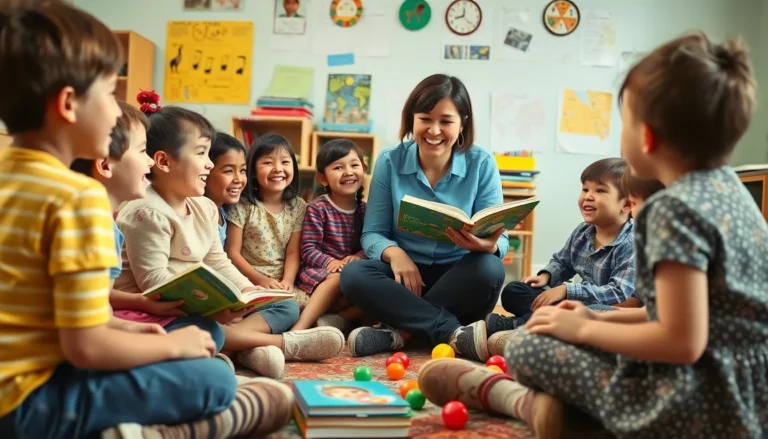Table of Contents
ToggleEffective parent-child communication is the secret sauce to a harmonious household. It’s like the Wi-Fi connection that keeps everything running smoothly—without it, things can get a little glitchy. Parents often find themselves scratching their heads, wondering how to bridge the gap between their world and their child’s. Kids, on the other hand, might feel like they’re speaking a different language altogether.
But fear not! With a few simple strategies, parents can turn those awkward conversations into meaningful exchanges. Imagine a world where “Because I said so” is replaced with engaging dialogues and genuine understanding. It’s not just about sharing information; it’s about building trust and connection. So grab a snack, settle in, and get ready to transform those everyday chats into powerful moments that strengthen the bond between parent and child.
Understanding Parent-Child Communication
Effective parent-child communication forms the foundation of a strong relationship. It involves understanding each other’s needs, feelings, and experiences.
Importance of Effective Communication
Effective communication fosters trust and openness. Children feel more secure sharing their thoughts and emotions when parents listen actively. Discussions about daily events, feelings, and problems help build a supportive environment. Engaging in regular conversations allows parents to understand their children’s perspectives better. Healthy communication skills also contribute to improved behavior and academic performance. When children feel heard, they develop confidence in expressing themselves.
Common Barriers to Communication
Common barriers impede successful communication. Lack of time often prevents meaningful interactions. Distractions from devices or external factors can create additional noise during conversations. Additionally, parents may resort to an authoritative tone, causing children to shut down. Misinterpretations arise when messages aren’t conveyed clearly, leading to frustration on both sides. Finally, differing communication styles may hinder understanding, particularly between generations. Addressing these barriers enhances the quality of conversations.
Strategies for Improving Communication

Improving parent-child communication involves practical strategies that foster connection and understanding. Implementing these approaches can strengthen relationships and enhance overall family dynamics.
Active Listening Techniques
Active listening involves fully focusing on what a child is saying. Parents should maintain eye contact to show engagement and use appropriate body language. Reflecting back on what a child expresses encourages them to share more. Asking open-ended questions promotes further discussion, making conversations richer. Parents can also acknowledge feelings by validating a child’s emotions, which fosters trust. Silence can be powerful; allowing pauses gives children time to think and respond comfortably.
Encouraging Open Dialogue
Encouraging open dialogue allows children to express themselves freely. Establishing a judgment-free zone provides a safe space for sharing thoughts. Parents can initiate discussions by asking about a child’s day, featuring simple prompts related to their interests. Discussing various topics, whether joy or concerns, creates a routine of communication. Setting aside dedicated time for chats emphasizes the importance of these conversations. Practicing empathy when children talk about challenges helps them feel understood and supported.
The Role of Nonverbal Communication
Nonverbal communication plays a crucial role in parent-child interactions. This form of communication encompasses body language, tone, and emotions, often conveying more than words alone.
Body Language and Its Impact
Body language significantly influences how messages are received. Maintaining eye contact shows attentiveness and respect, making children feel valued. Open body posture creates a welcoming atmosphere, encouraging more honest exchanges. Proximity matters as well; a comfortable distance can foster intimacy, while too much space may feel distant. Parents should also observe their children’s nonverbal cues. These signals can provide insight into their feelings, helping parents navigate conversations more effectively.
The Influence of Tone and Emotion
Tone of voice communicates emotions that words sometimes cannot capture. A warm, gentle tone fosters a safe environment, prompting children to share openly. Alternately, a harsh tone can shut down communication, instilling fear or defensiveness. Emotional expressions, such as smiles or frowns, reinforce verbal messages and clarify intent. Being aware of one’s tone and emotional state during discussions can significantly enhance dialogue. This awareness helps maintain a nurturing atmosphere essential for healthy communication and connection.
Communication Across Different Ages
Effective communication varies significantly across different stages of childhood. Understanding these differences can enhance parent-child interactions and strengthen their bond.
Infants and Toddlers
Infants and toddlers communicate primarily through nonverbal cues. Parents respond to babbles and facial expressions to establish early connections. Engaging in playful interactions fosters a sense of security. Simple words and repetitive phrases help in language development. Eye contact serves as a critical element to establish trust and encourage bonding. During routines like feeding or playtime, sharing affectionate gestures strengthens emotional ties.
School-Aged Children
School-aged children begin to articulate their thoughts more clearly. Asking open-ended questions invites children to express feelings and opinions. Incorporating daily routines supports regular discussions about school and friendships. Active listening is essential at this stage; parents should repeat or summarize to ensure understanding. Using age-appropriate language keeps conversations relatable and meaningful. Valuing their insights creates a judgment-free environment, making it easier for children to share experiences and concerns.
Teenagers
Teenagers often seek independence, making communication especially critical. Encouraging honest discussions about challenges fosters mutual respect. Parents should practice empathy and acknowledge their feelings during conversations. Establishing boundaries helps maintain trust while allowing teens to express themselves. Active listening becomes vital; this age group values when parents validate their thoughts without immediate judgment. Frequent check-ins about their interests signal parental support and availability for serious conversations.
Effective parent-child communication is essential for nurturing strong relationships and fostering emotional security. By prioritizing open dialogue and understanding, parents can create a supportive environment where children feel safe to express themselves. Implementing strategies like active listening and validating emotions can significantly enhance these interactions.
Recognizing the unique communication needs at different developmental stages helps parents adapt their approach, ensuring meaningful connections throughout childhood. Ultimately, investing time and effort into improving communication not only strengthens the parent-child bond but also promotes healthier emotional development and well-being for children.







